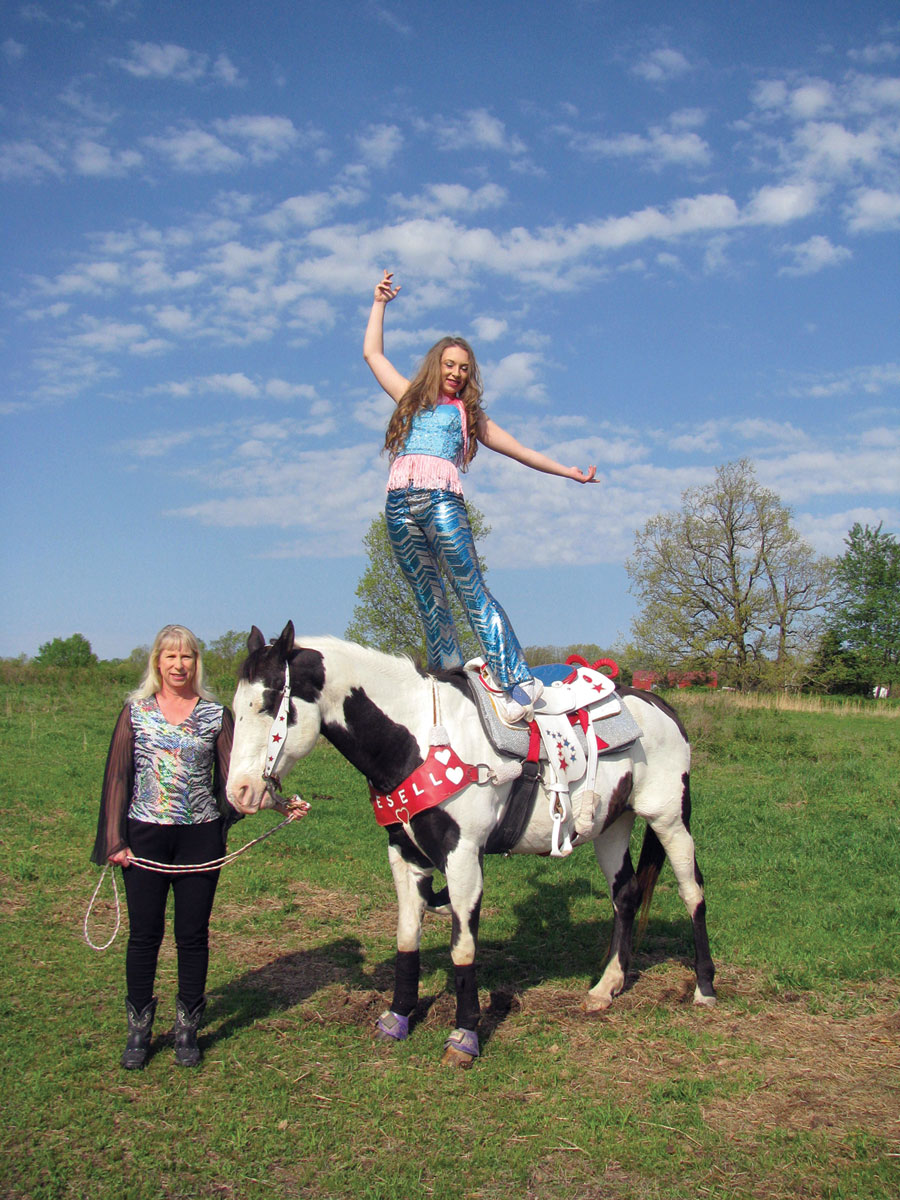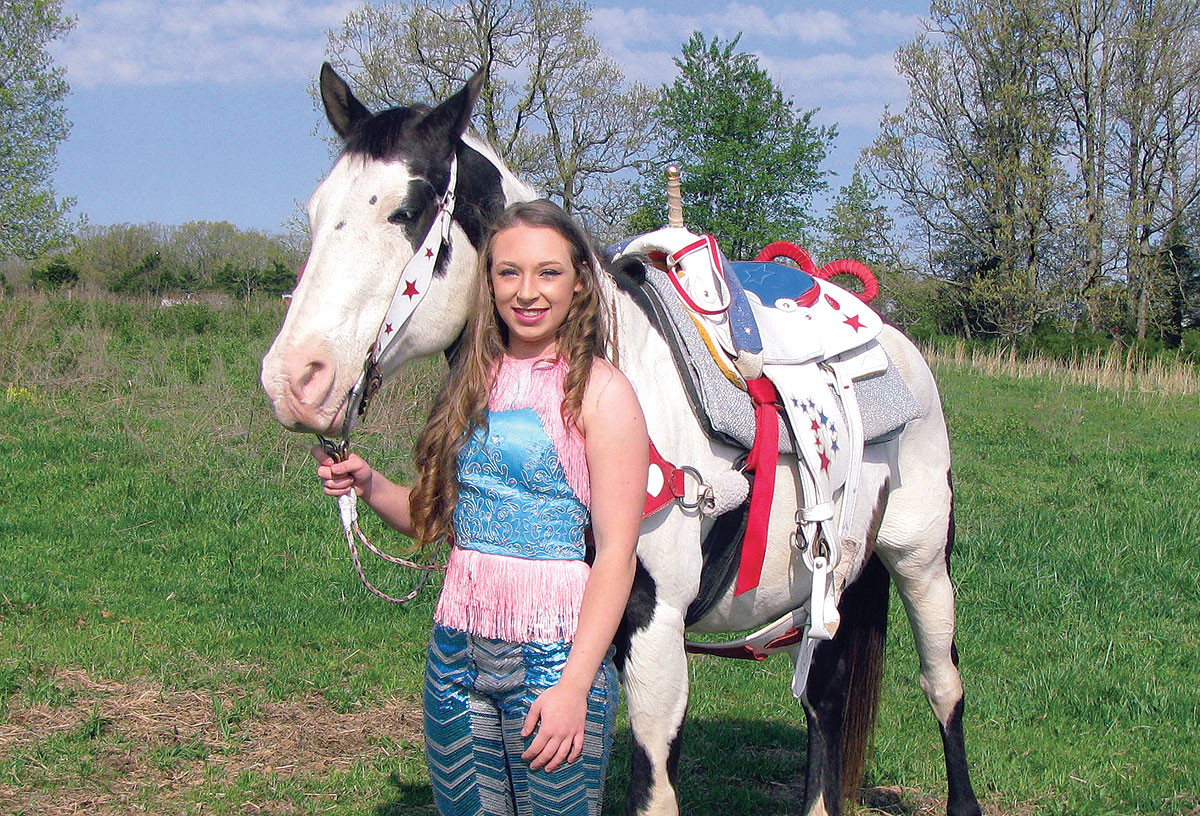 Regina Gesell began her trick-riding career in 1998 and her daughter is following her lead
Regina Gesell began her trick-riding career in 1998 and her daughter is following her lead
Childhood dreams can come true with hard work and determination. Regina Gesell saw her first trick rider when she was 5 or 6 years old. She still remembers the costume with long pink fringe and the white saddle.
“Afterwards, my dad took me up to meet her and she let me sit on her saddle and I knew that’s what I wanted to do,” she said. “So I came home and started playing on my little pony and I took some hay strings and some different straps and started trying to hang upside down. I got in trouble. My parents told me they didn’t want to see me do that anymore. So they didn’t for a long time, because I went further out in the field where they couldn’t see.”
Regina and her husband, Michael, live near Marshfield, Mo. in Webster County and own Gesell’s Specialty Acts. Regina has been doing trick riding since 1998. She trick rides at several equine affairs around the United States.
“I went to work at the Dixie Stampede in Branson, Mo., and I worked there for two years,” Regina said. “It was lots of fun.”
She was there in 1998 and part of 1999.
“We got a job opportunity to go to Six Flags and work at Chicago Six Flags and do a stunt show and learn stunt work and take our own horses.” Regina explained, “I wanted to be able to take my own, and of course it was more money if you owned the animals. We got to learn stunts and learn from a guy from California that came and taught us how to do teeter board flips, high falls, saddle falls, and we also learned how to do full body burns.
“The full body burn is when they put a suit on you. It has special chemicals on the back of the suit that won’t burn through it. They set you afire and you have to come, like you’re scared, raging out of a building, screaming. When they filmed mine, I was smiling and happy, because you don’t feel it. He said, ‘Don’t smile. Look mad!’ He said I looked like I was going to do a commercial for make-up instead of a full-body burn.”
They did five shows a day there, seven days a week, and only came home one time in six months. That was in 1999.
Regina was taught the harder tricks by a lady at the Dixie Stampede.
“The lady tied the horse that I had to a big post backstage and made me practice getting in and out of the tricks for probably two weeks on each trick,” Regina said. “That way I would memorize it. She said in case your horse ever started to trip or fall, you need to learn where to grab, where to go, where your possible exit strategies are. It probably took about two months.”
At the Dixie Stampede, Regina used their horse. But now uses her own.
“We train all of our own horses,” she said. “To trick ride, I only use Quarter horses. We have four that we use constantly, but we have 10 altogether.
“Each horse is different. I was really lucky years ago when we first started out. I had three horses that we chose and they took to it and had the pattern down and you could trust them within a month of doing it. I have another one and he’s going on three years (of training) and I’m just now trusting him. I got spoiled when the old guys learned it so quickly.”
They never use horses under about 10 years old. Regina said it is because the younger ones are “still green and flighty.”
“They still get distracted easy,” Regina said. “We really take time with them. We set up flags in the arena and let them look at flags and look at streamers. We try to get them used to what they might see. Our arena is close to the road. I don’t expect them, when they’re running pattern, to slow down or speed up when vehicles go by. I want them to stay the same and correct every time.”
Her husband, Michael, trick rode until about three years ago. Now he does stilt walking. He dresses up as a cowboy and entertains the kids when they go to shows.
Their daughter, Cheyenne, has been trick riding since she was 5 years old. She is now 16. Taught by her mother, Cheyenne started on a little white miniature pony and her dad built her saddles.
“I was just on a lunge line, so if anything went wrong she could pull me in instantly to stop him,” Cheyenne said.
She’s moved up from the pony.
Her favorite trick is the Sideback Bend.
“You have one foot in a 2-inch dog collar and the other is in a stirrup and you twist sideways and upside down to where your head is about even with your horse’s head,” Cheyenne said.
Cheyenne has been doing Roman Riding for about three years. That is standing with one foot on each horse.
“There’s a trick called the Liberty Stand, where you put two feet in the top of the saddle and your ankles are both strapped in and you lean forward out over the top of the horse. If that horse stops, jerks, or goes sideways and you fall out of it, it usually breaks both your ankles instantly. Another trick rider, this past summer, had that happen,” Regina explained.
Then there is a trick called the Apache Hideaway.
“It’s actually one of the crowd’s favorites and it’s the easiest and safest tricks we do,” Regina said. “But the crowd likes it the best. We will twist sideways and lay even with the horse. The reason it’s called the Apache Hideaway; it was actually invented by the Indians. They used to do it to spear buffalo.”
Regina’s advice for anyone wanting to learn trick riding is to get professional lessons.
“There are a few people that know just a few tricks and they may know the tricks, but if they’ve only worked on one horse, it’s actually the horse that’s carrying your body and taking care of you,” Regina said. “He’s your safe zone and the most important part is actually a bond with your horse.”
The Gesells are also planning to start teaching trick riding. “We’re going to start a school and start clinics where we do three- or four-day clinics in the summer,” Regina said.







